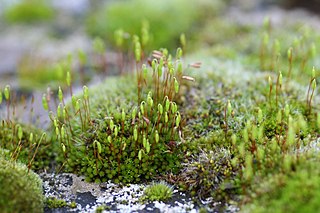
Spanish moss is an epiphytic flowering plant that often grows upon large trees in tropical and subtropical climates. It is native to much of Mexico, Bermuda, the Bahamas, Central America, South America, the Southern United States, and West Indies. It has been naturalized in Queensland (Australia). It is known as "grandpa's beard" in French Polynesia.

Taxodium ascendens, also known as pond cypress, is a deciduous conifer of the genus Taxodium, native to North America. Many botanists treat it as a variety of bald cypress, Taxodium distichum rather than as a distinct species, but it differs in habitat, occurring mainly in still blackwater rivers, ponds and swamps without silt-rich flood deposits. It predominates in cypress dome habitats.

Lycopodium clavatum is the most widespread species in the genus Lycopodium in the clubmoss family.

Taxodium distichum is a deciduous conifer in the family Cupressaceae. It is native to the southeastern United States. Hardy and tough, this tree adapts to a wide range of soil types, whether wet, salty, dry, or swampy. It is noted for the russet-red fall color of its lacy needles.

Vaccinium uliginosum is a Eurasian and North American flowering plant in the genus Vaccinium within the heath family.

Sagina subulata (, the heath pearlwort, Irish-moss, awl-leaf pearlwort or Scottish moss, is a species of flowering plant in the pink and carnation family Caryophyllaceae. It is native to Europe, from Iceland south to Spain, and east to southern Sweden and Romania. It occurs on dry sandy or gravelly soils.

Tillandsia recurvata, commonly known as small ballmoss or ball moss, is a flowering plant in the family Bromeliaceae that grows upon larger host plants. It grows well in areas with low light, little airflow, and high humidity, which is commonly provided by southern shade trees, often the southern live oak. It is not a parasite like mistletoe, but an epiphyte like its relative Spanish moss.

Bryales is an order of mosses.

Selaginella selaginoides is a non-flowering plant of the spikemoss genus Selaginella with a wide distribution around the Northern Hemisphere. It resembles a moss in appearance but is a vascular plant belonging to the division Lycopodiophyta. It has a number of common names including lesser clubmoss, club spikemoss, northern spikemoss, low spikemoss and prickly mountain-moss. This plant has one close relative, Selaginella deflexa, native to Hawaii. These two plants form a small clade that is sister to all other Selaginella species.

Lycopodiella inundata is a species of club moss known by the common names inundated club moss, marsh clubmoss and northern bog club moss. It has a circumpolar and circumboreal distribution, occurring throughout the northern Northern Hemisphere from the Arctic to montane temperate regions in Eurasia and North America. It grows in wet habitat, such as bogs, ponds, moist spots on the tundra, and long-standing borrow pits.

Polypodium appalachianum is a fern species native to eastern North America. Sometimes called the Appalachian polypody or Appalachian rockcap fern, it is very similar in appearance to Polypodium virginianum. For years, P. virginianum—long considered a variety of the British Polypodium vulgare—was recognized as having cryptic races, with diploid, triploid, and tetraploid representatives. Since the triploid specimens bore abortive spores, it was apparently the hybrid between the diploid and tetraploid groups. In 1991, it was resolved that the type of P. virginianum was the tetraploid series, and that it is an allotetraploid species of hybrid origin, with the diploid species as one parent. The diploid species was then named P. appalachianum. The other parent of P. virginianum was found to be Polypodium sibiricum. The tetraploid of hybrid derivation tolerates warmer climates than either parent.

Styrax americanus, the American snowbell or mock-orange, is a plant species native to the southeastern United States and the Ohio Valley. It has been reported from Texas and Florida to Virginia and Missouri. It generally grows in swamps and on floodplains and in other wet locations.

Balduina uniflora is a North American species of plants in the sunflower family. It is native to the southeastern United States. It is the type species of Genus Balduina.

Trichophorum cespitosum, commonly known as deergrass or tufted bulrush, is a species of flowering plant in the sedge family. It was originally described by the Swedish naturalist Carl Linnaeus in 1753 as Scirpus cespitosus, but was transferred to the genus Trichophorum by the Swedish botanist Carl Johan Hartman in 1849, becoming Trichophorum cespitosum.

Hypericum tetrapetalum, the fourpetal St. Johnswort, is a species of flowering plant in the St. John's wort family, Hypericaceae. It is found in the Southeastern United States and Cuba. It was first described by Jean-Baptiste Lamarck in 1797.
Hypericum myrtifolium, the myrtleleaf St. Johnswort, is a species of flowering plant in the St. John's wort family, Hypericaceae. It is endemic to the Southeastern United States. It was first described by Jean-Baptiste Lamarck in 1797.

Rhizomnium is a genus of mosses in the family Mniaceae commonly referred to as leafy mosses. They grow nearly worldwide, mostly in the northern hemisphere.

Glyceria canadensis is a species of grass in the genus Glyceria which is known by the common name rattlesnake mannagrass. It is native to North America, from British Columbia to Newfoundland and south to North Carolina. It is commonly found in wet areas.

Carex baileyi is a sedge in section Vesicariae the genus Carex native to the Appalachian mountains in Eastern North America. It is commonly called Bailey's sedge. Carex baileyi was named in honor of Liberty Hyde Bailey by its discoverer, Nathaniel_Lord_Britton.

Sphenopholis intermedia, the slender wedgegrass or slender wedgescale, is an annual grass native to North America. The specific epithet "intermedia" means "intermediate". The diploid number is 14.



















